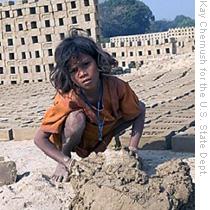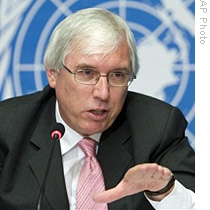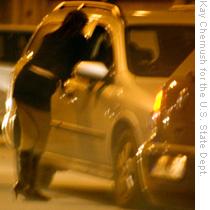Geneva
21 August 2009
 |
| A 9-year-old girl was trafficked with her entire family from Bihar, one of the poorest and most underdeveloped states in India, and sold to the owner of a brick-making factory |
Men, women and children are no longer shackled, put on the auction block and sold like prize cattle to the highest bidder. In today's world, one person does not buy another and own him or her for life. Traditional forms of slavery have been abolished. But, contemporary forms of slavery are often as cruel and dehumanizing.
Modern forms of slavery
 |
| Roger Plant (file photo) |
"You are in a forced labor situation when you enter work or service," he said. "It does not have to be legal work. It can be begging. It can be all kinds of activity. You enter it against your freedom of choice, and you cannot get out of it without punishment or the threat of punishment."
Plant says this definition, which first appeared in a 1930 ILO Convention Against Forced Labor, is still valid today.
He says most forced labor is in the private economy, and it is usually for several months or years. While lifetime cases of forced labor, slavery and bonded labor do exist, he says they are the exception.
"What we are finding is that migrant workers, particularly irregular migrant workers, very often young women, around the world are at tremendous risk of serious exploitation," said Plant. "We are finding that this is not only in the backward economy of developing countries, even though most forced labor today is indeed in the informal or the background agricultural sector of Asia, Latin America and then Africa."
Plant says every single country in the world is encountering problems of forced labor. That is because the victims are vulnerable to exploitation, laws against this practice are not vigorously enforced and it is a hugely profitable trade.
A recent ILO study finds an estimated $28 billion is made from trafficking for sexual exploitation every year. And at least $21 billion is made from all other forms of forced labor.
Apart from the severe human rights violations, Plant says, the profits pocketed by traffickers represent lost tax revenues to the States, as well as lost earnings stolen from the victims of forced labor and trafficking.
"I think it is very likely that that is worth even more now," he said. "So, we could be talking about figures way, way above $50 billion or $60 billion. Way above, if we are talking about all forms of exploitation."
Risk-takers and victims
Policy Officer at the ILO's Special Action Program to Combat Forced Labor Beate Andrees says migrant workers see themselves as risk-takers. They believe their lives will improve by getting a job in a foreign country. But, she says things often turn out badly as they maneuver through the migration system.
"You need documents, you need a contract, you need to cross borders, you need to have an employer, the employer actually has to have work for you," said Andrees. "And, then at each of these points, you can be deceived, and each of the people involved, they take a cut of the fees you have to pay. And, this is the mechanism that leads into this vicious cycle where you suddenly do not see or do not perceive to have any alternative."
 |
| This woman used in prostitution in Western Europe is forced through threats and intimidation to give all earnings to her trafficker (file photo) |
"One of the worst things about human trafficking it is that the people who actually are the traffickers or who become the middle-men for the traffickers are very, very close to the victims of trafficking," she said. "More often than not they are closely related to them or are close friends of the family."
Pandya says this is a common occurrence in Eastern European countries. She says poor women there frequently are duped by people they trust into going to Western countries by promises of legitimate work.
"Either once they have left their country and are on route, or when they have actually arrived in the country of destination, that their passports are taken way, they are locked up and then they are forced into prostitution," said Pandya.
More often than not, laws that exist to protect people against forced labor are not enforced. Frequently, it is the victim of trafficking who is criminalized, not the trafficker. Studies show prosecution rates for these crimes are extremely low the world over.
Anti-slavery advocates say the worst aspects of forced labor can be lessened if people are made aware of the harm it inflicts. They say when people learn that the prostitute in a brothel may be an unwilling victim of sexual exploitation or the cheap jeans they buy in a store are produced by people working 12 hours a day for little or no pay, some of these forms of contemporary slavery may dry up.